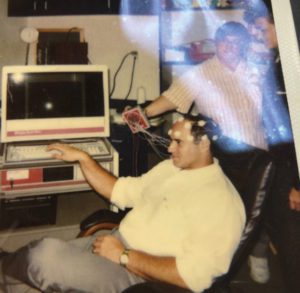By Robert W. Pollack, M.D. CEO
Quantitative Electroencephalograms (QEEG’s) Help us ‘See’ Depression QEEGs have allowed us to repurpose existing neurological tests to help us better diagnose and treat major depressive, and related, disorders. Until now, we have bolstered a solid history and mental status examination with direct patient queries, objective written tests and scales. Technology and neurochemistry have given us additional tools such as pharmacogenomics and have now brought back the usefulness of (QEEG)s to assist us in “seeing” depression. Not only does this enable clinicians to make more accurate diagnoses and helps choose between rTMS, TBS and Ketamine as treatment modalities. We can now use P-300s and FVEPs as evoked potentials that help us get more physiological evidence about the depression being suffered.

Step 1: The Odd-Ball Paradigm (P-300 Auditory Evoked Potential)
The first of these is called the P-300 Auditory Evoked Potential. It utilizes a sequence of tones of different decibels (tone burst stimuli) and therefore is referred to as the Odd-Ball Paradigm. The test is administered with the patient wearing an EEG headset and sitting in a comfortable chair. The program runs and presents the patient with an 80 decibel intensity pair of tones at 1000hz and 2000hz respectively. The stimuli are delivered bilaterally. The results then reflect the:
• Focus on the tones
• Discriminate ability of the patient
• Time needed to cognitively deal with the process

We then review the times (latencies) and get a view of the patients’ ability to process the information. This assists us in better diagnosing early Alzheimer’s Disease, Major Depressive Disorder, Attentional Disorders as well as seeing the impact of proper thyroid medications and the desired effects. It is non-invasive, requires no premedication and the patient is a passive participant (while the brain does all of the work).

Step 2: An Eye-Test That Serves as a Window into Depression
The next is called the Flash Visual Evoked Potential or FVEP. Here the patient wears the EEG headset (wireless) and is presented with a checkered Screen. The squares then alternate white/black and the impulses generated through the eyes are recorded. The optic tracks cover a major percentage of the brains geography and we are able to observe many functions during a 100 ms time span. In addition to the physical findings consistent with structural illnesses, we can observe processing time that reflects depression. This is due to the arousal dysregulation of the brain during depression as well as other processing disorders such as ADHD. The signal generator and the recording EEG does the work while the patient simply focuses on the screen.

These Tests Tell us How Well Treatments like Ketamine and TMS are Working to Heal Depression
Depression is a disease of neuronal neuroplasticity. FVEP can be used to measure long-term potential (LTP) mediated neural plasticity allowing us to assess Ketamine’s effects (how well it works).
We at Psychiatric Associates of Southwest Florida continue to strive to utilize many mechanisms to bring quality treatment to our patients.
Visit us on our Website and on Facebook, LinkedIn, Twitter and Pinterest to follow our quest to beat the Disease of Depression and add quality to the lives of our patients.
PASWFL.com
6804 Porto Fino Cir #1, Fort Myers, FL 33912
Office: 239-332-4700









